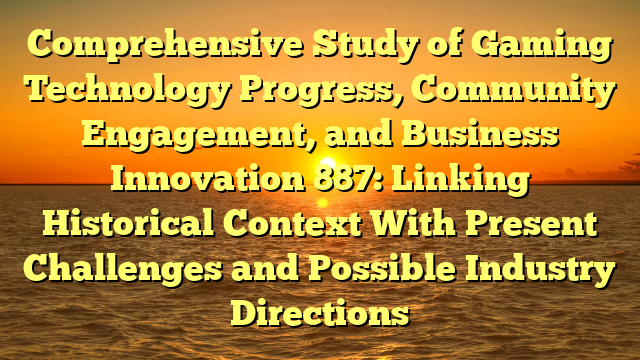Comprehensive Study of Gaming Technology Progress, Community Engagement, and Business
Innovation 887: linking historical context with present challenges and possible industry
directions has become a defining theme in the gaming industry, shaping both players and
developers. In Southeast Asia, the conversation around comprehensive study of gaming
technology progress, community engagement, and business innovation 887: linking
historical context with present challenges and possible industry directions reflects
wider cultural and economic forces. The evolution of games is influenced by regulation
and consumer sentiment, while communities push boundaries of creativity.
Looking back to the 2008 financial crisis, gaming took new forms that altered how
players engaged with technology. Milestones in game history highlight shifts in
technology, audience expectations, and design philosophy.
Today, comprehensive study of gaming technology progress, community engagement, and
business innovation 887: linking historical context with present challenges and possible
industry directions is experiencing new momentum as hardware, networks, and platforms
converge. login gacototo are experimenting with innovative mechanics while balancing
commercial pressures.
Take a logistics firm rerouting ships around chokepoints, a case that shows how
innovation responds to challenges in the gaming world. Similarly, a university–industry
program training mid-career workers underlines the potential for collaboration between
creators and consumers.
Technology plays a crucial role. Faster processors, cloud services, and digital
distribution change how games are made and played. Financing models also shift, from
crowdfunding to subscription-based libraries.
Challenges remain: skills shortages and data privacy concerns continue to shape the
risks developers and players face. Regulators, studios, and fans often debate how best
to balance opportunity with responsibility.
Players, developers, publishers, and investors each view progress differently. For fans,
it’s about fun and identity; for companies, it’s about strategy and survival.
As the industry matures, debates grow sharper. Policymakers and educators ask how games
shape learning and behavior. For Southeast Asia, the balance between innovation and
responsibility remains delicate but vital.
Moving forward, open data and interoperability standards and targeted subsidies with
sunset clauses could help ensure that comprehensive study of gaming technology progress,
community engagement, and business innovation 887: linking historical context with
present challenges and possible industry directions grows in sustainable, inclusive
ways. The outcome will define not only business models but also cultural impact in years
ahead.
Comprehensive Study of Gaming Technology Progress, Community Engagement, and Business Innovation 887: Linking Historical Context With Present Challenges and Possible Industry Directions
